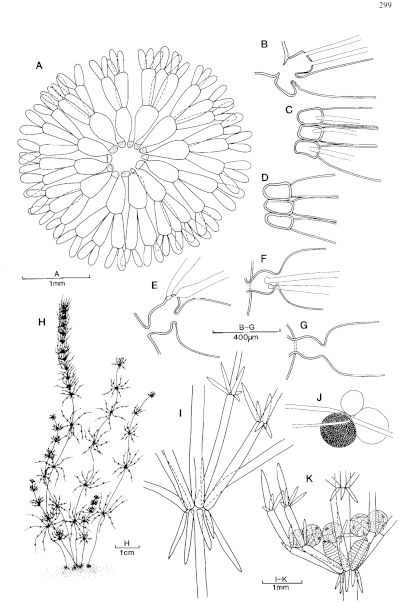|
|
|
|
|
|||||||||||
|
Electronic Flora of South Australia Species Fact Sheet
Phylum Chlorophyta – Order Dasycladales – Family Dasycladaceae
Selected citations: Gilbert 1978: 310, fig. 16. Valet 1969: 581, pl. 150 fig. 2.
Thallus (Fig. 101A) medium to dark green, with 1–16 axes arising from a rhizoidal holdfast. Axes 2–6 cm high, 2–4 mm thick, with a central siphon 0.5–1 mm broad with a thick lamellate wall, bearing close whorls of 10–12 branched laterals. Laterals (Fig. 102A) with segments of 3 orders, di- to penta-chotomous, cross walls with open septa; primary segments clavate to pyriform, 400–700 µm long and 200–400 µm in diameter; secondary segments terete to slightly swollen, 450–700 µm long and 120–200 µm in diameter; tertiary segments clavate, 130–400 AM long and 100–130 µm in diameter; secondary and tertiary segments often lost; chloroplasts small, round.
Reproduction: Reproduction unknown.
Type from Point Fowler, Great Australian Bight, S. Aust., uppermost sublittoral in sandyhollow (Womersley, 6.ii.1954; ADU, Al 9437, holotype and isotypes-"Marine Algae of southern Australia" No. 26).
Distribution: Only known from the type and from Hopetoun, W. Aust., 3–4 m deep on sand-covered rock near jetty (Kraft (6981) & Ricker, 16.viii.1979; ADU, A50718).
Taxonomic notes: This is a distinctive species for southern Australia, rare (but occurring in patches of many plants) and possibly dependent on slightly warmer temperatures of the Great Australian Bight region. Gilbert (1978) has discussed the differences between Dasyciadus and the related genus Chlorocladus Sonder.
References:
GILBERT, W.J. (1978). Observations on Dasycladus C. Agardh and Chlorocladus Sonder (Dasycladales, Chlorophyta) and description of Chlorocladus philippinensis Gilbert sp. nov. Phycologia 17, 305–310.
VALET, G. (1969). Contribution a l'étude des Dayscladales 2. Cytologie et reproduction. 3. Révision systématique. Nova Hedwigia 17, 551–644, Plates 133–162.
WOMERSLEY, H.B.S. (1955). New marine Chlorophyta from southern Australia. Pacif. Sci. 9, 387–395.
WOMERSLEY, H.B.S. (1956). A critical survey of the marine algae of southern Australia. I. Chlorophyta. Aust. J. mar. freshw. Res. 7, 343–383.
The Marine Benthic Flora of Southern Australia Part I complete list of references.
Publication:
Womersley, H.B.S. (31 May, 1984)
The Marine Benthic Flora of Southern Australia
Part I
©Board of the Botanic Gardens and State Herbarium, Government of South Australia
Illustrations in Womersley Part I, 1984: FIGS 101A, 102A.

Figure 101 enlarge
Fig. 101. A. Dasycladus densus (ADU, A19437 type). B. Acetabularia calyculus, living (ADU, A33400 collection). C–E. Polyphysa peniculus. C. Habit (ADU, A46701). D. Cap of young gametangial rays. E. Mature gametangial rays with cysts (D,E from culture).

Figure 102 enlarge
Fig. 102. A. Dasycladus densus (ADU, A19437), cross section of thallus; all walls between segments arc perforate. B–D. Acetabularia calyculus (ADU, A33400). B. Sectional view of gametangial ray with superior corona (bearing 2 hairs) and inferior corona. (After Womersley 1971, Fig. 15.) C. Superior corona with hairs, from above. D. Inferior corona, from below. E–G. Polyphysa peniculus (ADU, A54173). E. Sectional view of base of gametangial ray with superior corona (bearing 2 hairs) and slight bulge of inferior corona. F. Superior corona with two hairs, from above. G. Base of gametangial ray, from below. H–K. Lamprothamnium papulosum (ADU, A54177, from culture). H. Habit of thallus. I. Nodal branching with opposite stipulodes and bracts on two lateral branches. J. Starch bulbils on rhizoids, from muddy substrate. K. Part of fertile spike with antheridia on first node of branchlets and oogonia (two only shown) at base of whorl.

|
Email Contact: State Herbarium of South Australia |

|